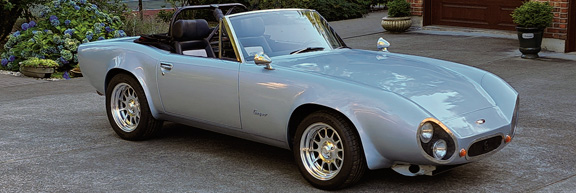|
|
Continued
from Previous
Interestingly enough, it would even be faster than a 1969 Corvette 427-435 Convertible (as driven by R&T).
High Performance is Small, Light, Nimble and Fast.
So Why Did I Build It?
A little over 44 years ago (1979?) I sold my 1968 Burnt Orange 327 Corvette convertible (It was too big, too heavy, too common, too slow and not really what I wanted, which I discovered after I had driven it for awhile).
R&T was not very impressed with the 1968 Vette either.[
read the
R&T 1968 Corvette Convertible 327-350hp Road Test
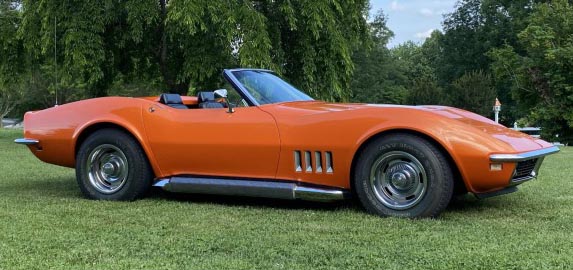 ]. I started looking around for something else that was smaller, lighter, faster and more fun to drive.
I thought about a Lotus Elan. About as far away from a 3200lbs (dry weight) Corvette as you can get at
1600lbs vs 3200lbs, but both with fiberglass bodies, independent rear suspension, and four wheel disc brakes. ]. I started looking around for something else that was smaller, lighter, faster and more fun to drive.
I thought about a Lotus Elan. About as far away from a 3200lbs (dry weight) Corvette as you can get at
1600lbs vs 3200lbs, but both with fiberglass bodies, independent rear suspension, and four wheel disc brakes.

1972 Lotus Elan great handling, braking and fun to drive but the Lotus Elan and the Lotus 26R are both very small cars and not fast enough
and not enough power. Or maybe buy this
car and cut the top off, which was
possible but an expensive option back in
the late 1970's.

Not a convertible,
the IMSA 240Z was a flat out racing car and yet the acceleration performance is inferior to a Jensen-Cooper because of more weight and less torque. Possibly a higher top speed, but not according to the specifications.
So...no to the Z Car or any other hardtop-to-ragtop option.
I really loved the oh-so-British cockpit of the Jensen-Healey, its small size, it was already a ragtop, plus the potential power of the small, lightweight 4 cylinder 16 valve DOHC
Lotus engine. It just felt perfect to me right from the start. I also thought the steel body was a bit higher quality than the Datsun.
Now that the Lotus Elan, Z Car or IMSA 240Z were excluded from consideration, what next? Back in 1983 there wasn't much to choose from, either older or newer cars, what with the government regulations on emissions and crash protection. There was even talk in 1975 that convertibles would be outlawed because of their lack of roll over safety. I think I must have looked at everything before deciding on a Jensen-Healey. The Jensen-Healey had so much potential that I just couldn't resist.
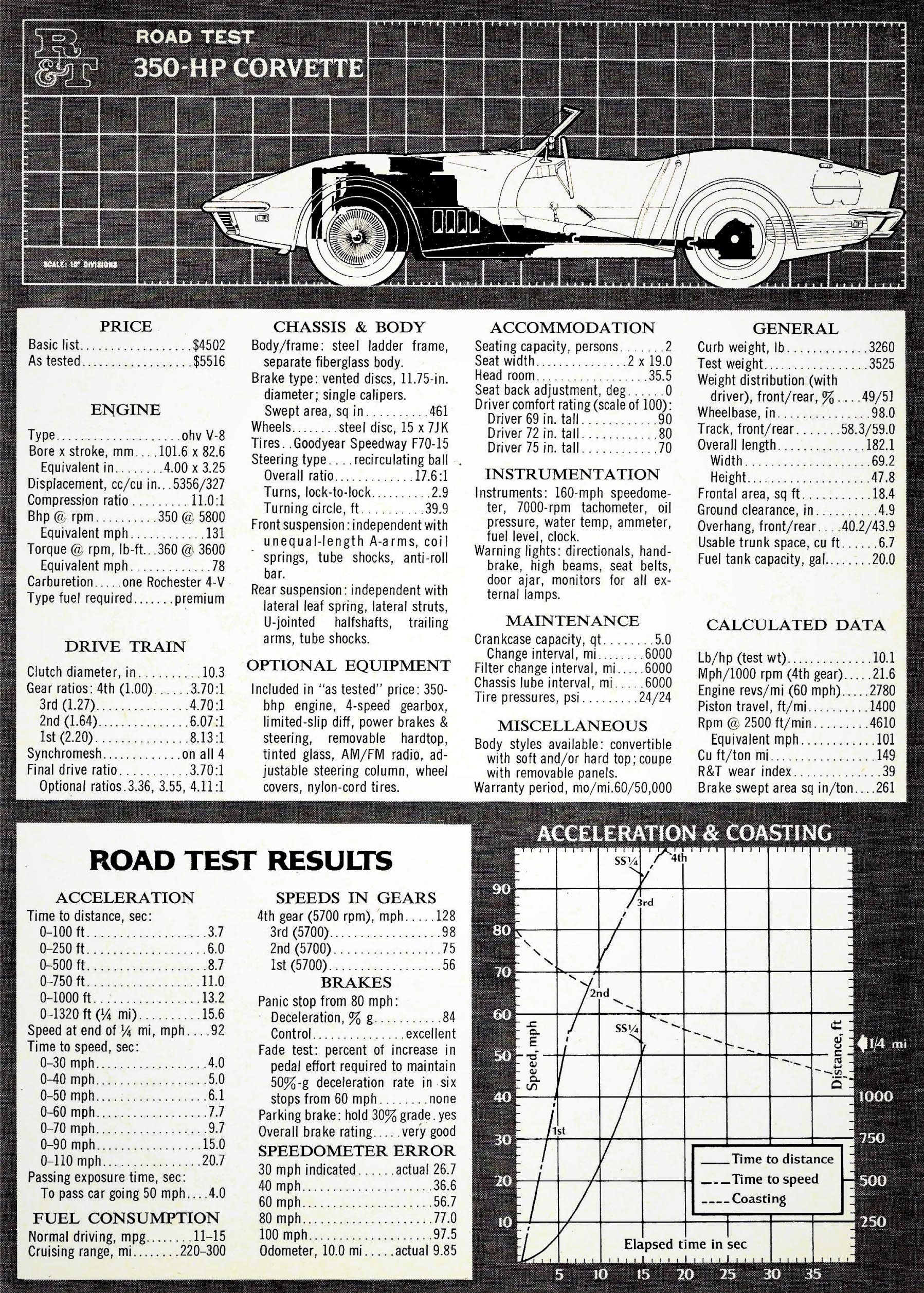
My old 1968 Corvette Convertibe, big and heavy and actually not that fast. Note that it is not as fast as the SCCA Jensen-Healey or a 1964 Shelby 289 Cobra. It is also the size of a Ferrari Daytona
- of course not the same speed or quality but both are big heavy cars. After having one big heavy car I had no desire for another, even if it was faster. I wanted something more fun. I was looking for something small, simple, nimble, fast and lightweight.
Something like a 1972 Lotus Elan or perhaps a Lotus 26R but bigger and faster but not as big as a Corvette or a Jaguar XK-E.
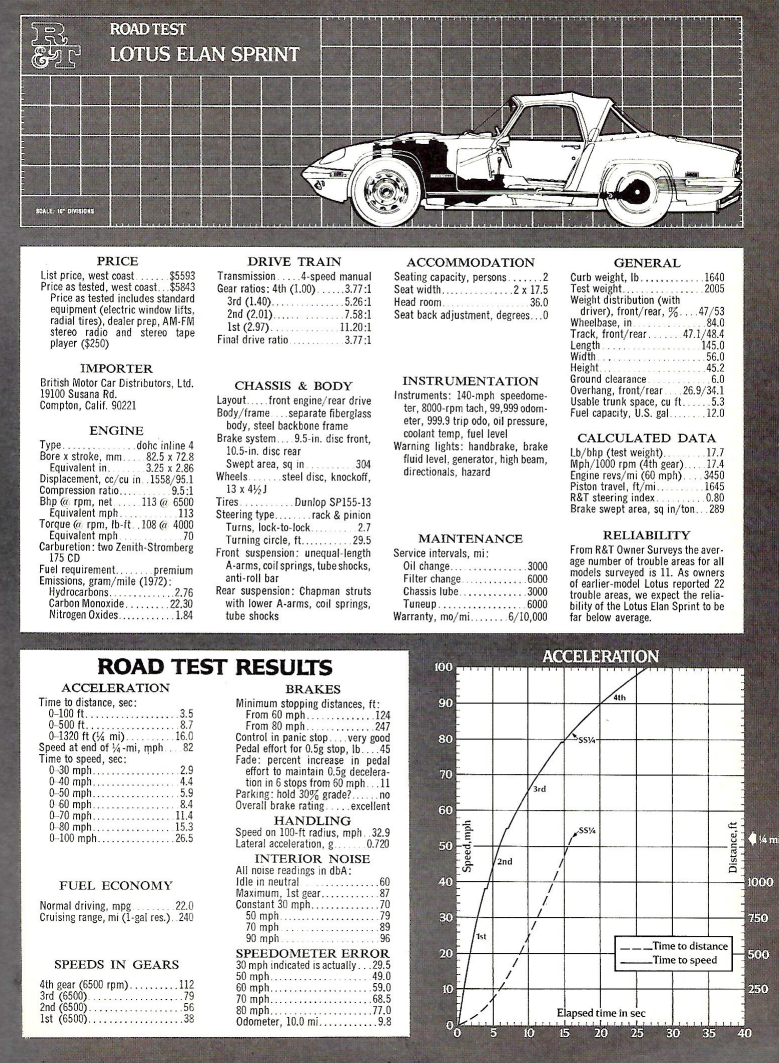
But any car I bought would have to fit
my 6'1”, 190lb frame. So the Lotus Elan
with it's 84” wheelbase was out of the
question. It is a tiny little car.
Besides, if you look at the numbers, a
stock Elan is not even as fast as a
stock Jensen-Healey and there was not as
much room for improvement as the J-H
with its 16 valve head (all of the
improvements are outside of the SCCA
rules, of course). The Lotus 26R was
faster but not any bigger, plus not a
good street car for summer driving with
my wife. Unacceptable.
So now, what
could I buy? Something bigger and faster
(or that could be made potentially
faster) than a Lotus, MG, Alfa, Fiat,
Opal, Sunbeam, Datsun or Triumph but
smaller than a Corvette or a Jaguar and
less expensive but just as fast (track
fast) as a 60's Ferrari, Aston Martin,
Lamborghini, Maserati, et al. And I
wanted a car that could be modified as
much as I wanted to suit me without
destroying the value. A fascinating
problem.
Every car I could think of was
too big, too small, too slow, too
clumsy, too old, too new or too
valuable. The J-H was the only car that
met most of my criteria and I wasn't
willing to comprise. Would you? So in
1982 I went to the Seattle Public
Library and looked through all the old
issues of Road & Track from the late
50's to 1982. I found an April 1973 R&T
Road Test of a 1973 Jensen-Healey. It
had
the new Lotus 907 DOHC all aluminum
slant 4 (which allowed for a low bonnet
line) with a 16
valve cylinder head but the
car didn't have the performance I
wanted. But then I read an article
in the September 1974 R&T about an SCCA
Jensen-Healey that was much closer in
performance to what I was looking for,
although it would probably not run on
the street. Too much of a dedicated
racing car for me. And ugly too. I
wanted a better looking and faster car
and to be able to drive my car everyday
and everywhere the sun was shining. But
this was nothing that some (actually, a
lot of) high performance modifications
beyond the SCCA rules couldn't fix. As
far as I could see a 1973 Jensen-Healey
was about 75% of what I wanted and the
other 25% was possible to modify into a
really great little convertible sports
car. I was definitely interested.
By the
way, any kind of modification that added
weight to the car beyond a roll bar and
bigger wheels and tires was out of the
question. This ruled out any big engine
swaps, etc. I really wanted a 2000lb 250
hp car, not a 3000lb 375 hp car or worse
a 4000lb 500 hp car. Or as close as I
could get. There is more to (my) life
than raw horsepower. Small, light,
simple, nimble, good looking and fast
was the name of the game. I wanted a
road racing auto-crossing car, not a
drag racer. Autocross and track days
were hopefully in the future.

 Too big & too clumsy, 1968 Corvette Convertible vrsus Jensen-Cooper Too big & too clumsy, 1968 Corvette Convertible vrsus Jensen-Cooper

 Too small & not a true convertible, 1972 Dino 246 versus Jensen-Cooper Too small & not a true convertible, 1972 Dino 246 versus Jensen-Cooper

 Too big & too valuable to modify, 1961 Jaguar XK-E versus Jensen-Cooper Too big & too valuable to modify, 1961 Jaguar XK-E versus Jensen-Cooper

 Too big and way way too expensive-but beautiful, 1967 NART Spider versus Jensen-Cooper Too big and way way too expensive-but beautiful, 1967 NART Spider versus Jensen-Cooper

 SCCA Huffaker D Production Jensen-Healey versus my Jensen Cooper SCCA Huffaker D Production Jensen-Healey versus my Jensen Cooper
Obviously the Huffaker was not a good street car and not quite fast enough.
It was also ugly but with great handling and lots and lots of potential speed. The Lotus 907 engine was originally conceived as both a street engine and a 2000cc Formula 2 racing engine.
Just below are two Jensen-Healey road tests from back in the day
by Road & Track and below that from Car & Driver
(note the faster acceleration times than R&T and better braking). I have a feeling that the C&D test drivers were more aggressive launching the car off the line.
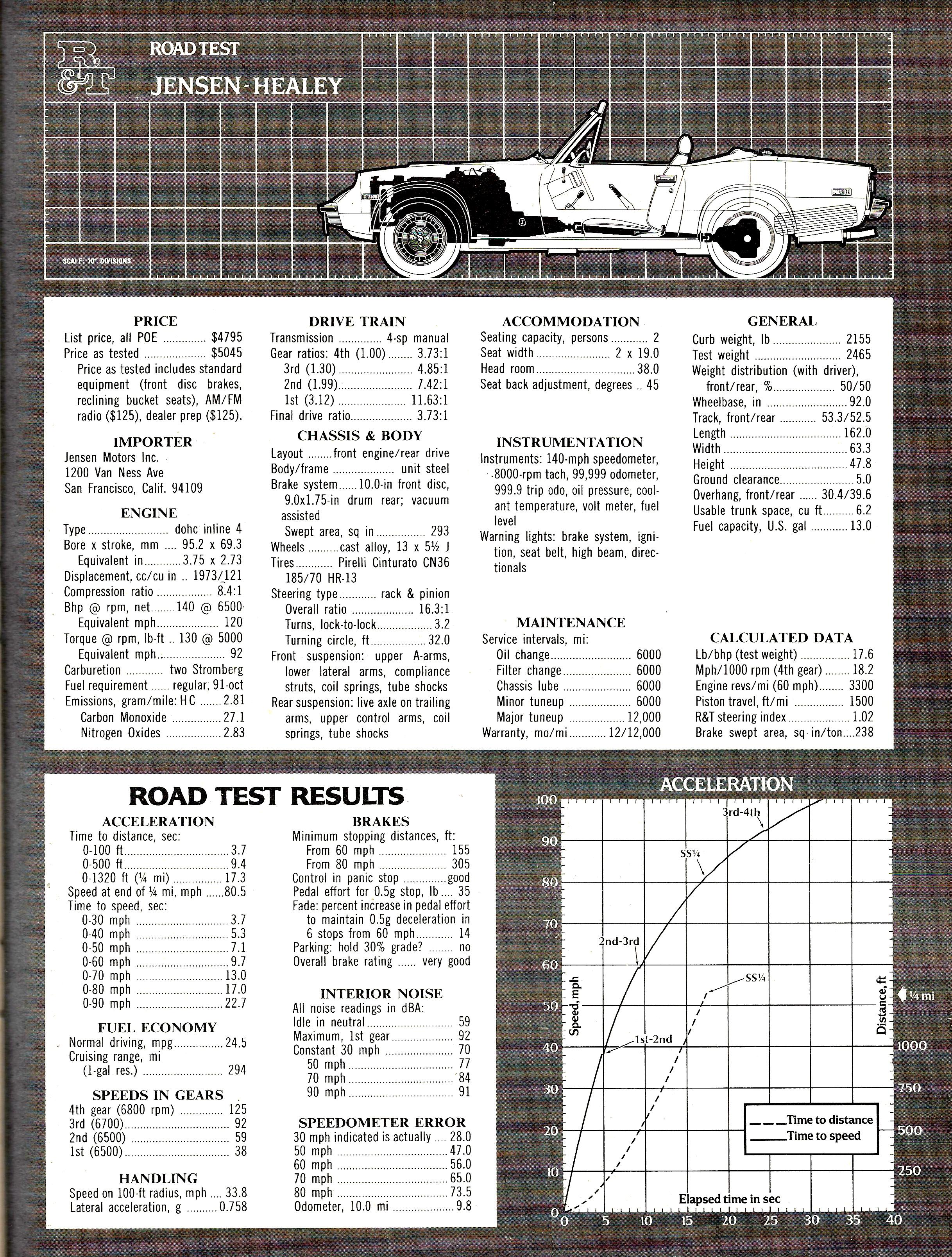
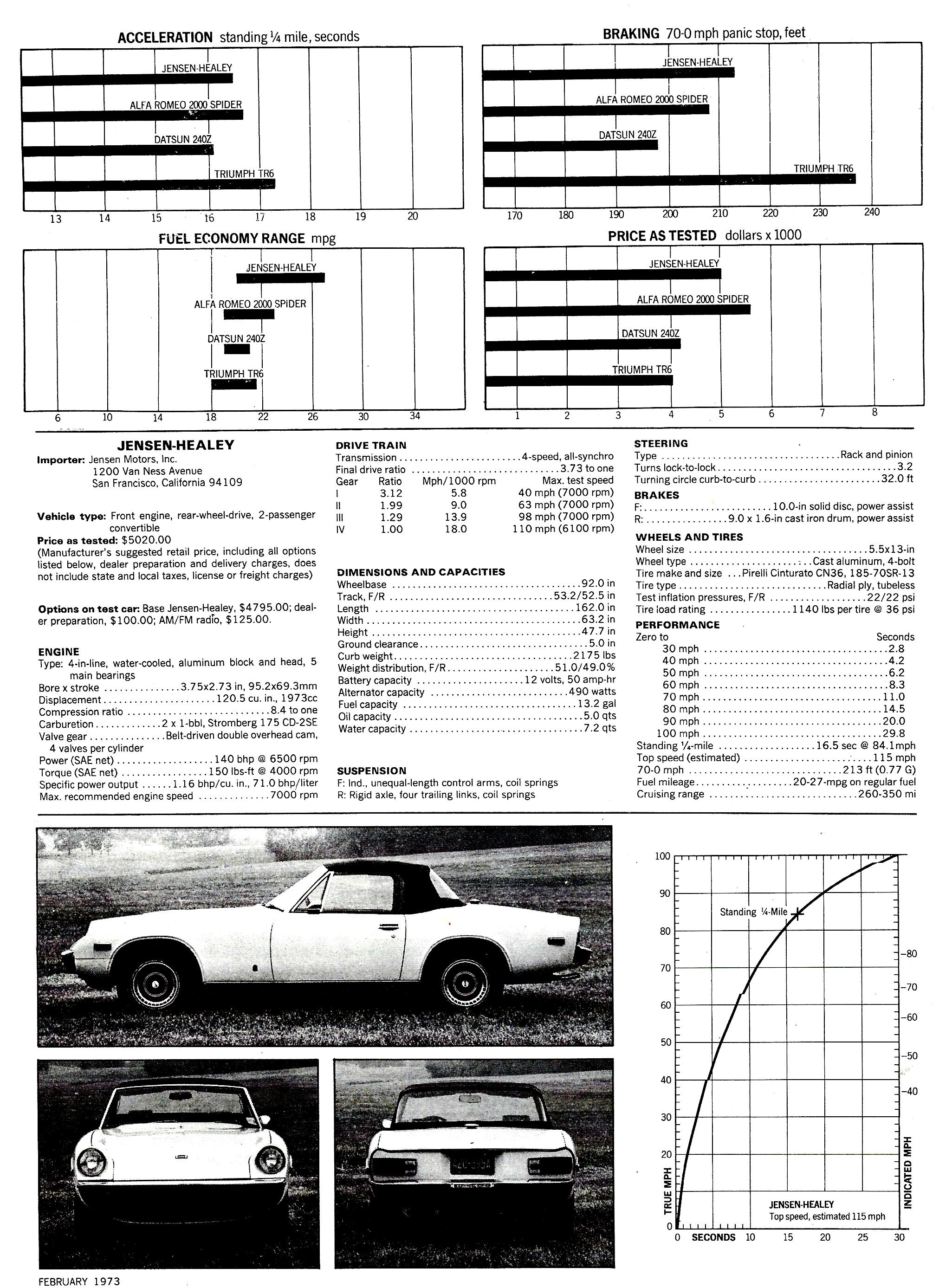
By modern standards very small wheels and tires but room to upgrade to 15" & 16" performance tires. I was getting closer and closer to finding my ideal sports car, but it was obvious that anything I bought was going to need a lot of customizing if I was going to get what I wanted.
Racing Huffaker D-Production Jensen-Healey had greatly improved performance
[click
here for complete 1974 road test].
The speed for the lateral acceleration was an error (should be 40.8 mph) but the 1.112g's is correct. Faster than the stock '68 Vette and almost as fast as a '64 Cobra with better handling because it is
smaller & lighter. Note the gearing problems. The Getrag 5 speed gearbox and bigger tires avoids this.
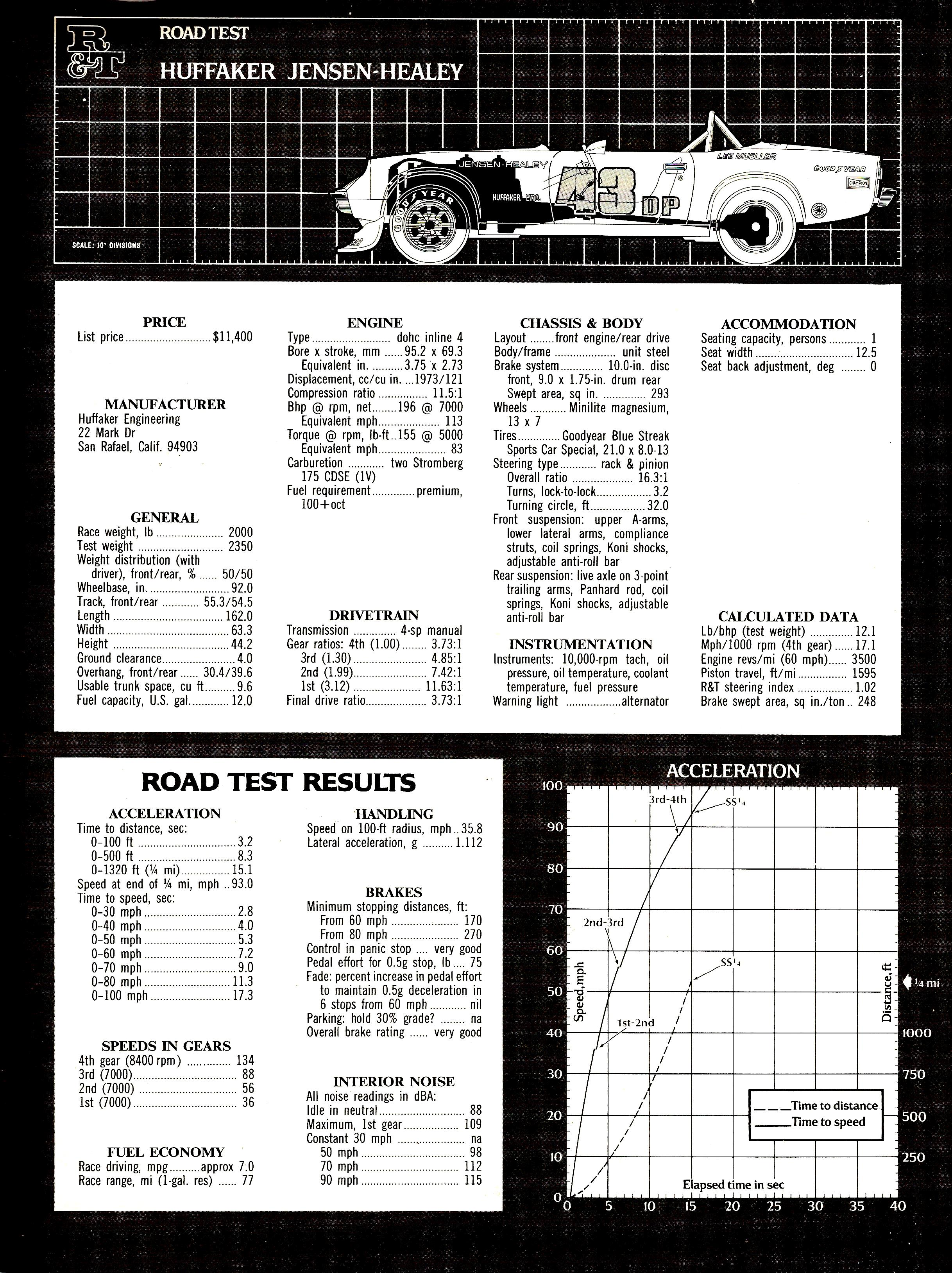
The SCCA Jensen-Healey was almost what I wanted, and was 15 secs faster 0-100 mph, but not quite. Also note that the 13" tires limited the top speed to 134 mph (at 8400 rpm !!!)
In the September 1974 Road & Track road test at Riverside Raceway the authors were very impressed with the performance of the car. So was I.
The SCCA Jensen-Healey was 24 seconds faster per lap than the stock Jensen-Healey - which shows it's potential. An interesting side note from present day 2023 is that apparently I am not the only sports car fan who thinks smaller and lighter is better. Recent Hagerty Insurance (where I insure my car) values are showing that the smaller Ferrari Dino 246 GT is going up and passing the much larger Ferrari Daytona in price. Would I prefer a Dino to a Daytona
[see
full Daytona road test here]? More fun to drive? I would think so, but anyway I can't fit in a Dino (I tried), it was too slow and it is not a real convertible, even if it does have a removable targa top.
 Cont
Page 3 Cont
Page 3
|
The Ultimate Jensen Healey site is
maintained by Prestek Design Services, Bothell, WA
|
|

